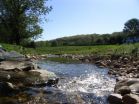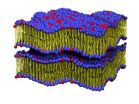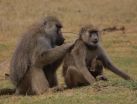(Press-News.org) Most people think of city landscapes as simpler, diminished versions of the wild forests and free-flowing streams found in remote places. But in a series of studies published Sept. 10, 2014 in a special issue of the journal Biogeochemistry, scientists specializing in urban ecosystems say just the opposite is true. Urban landscapes are more complex than they seem, and from coast to coast these ecosystems can work in surprisingly similar ways, regardless of local conditions. And they have the potential to change quickly – for better or worse – depending on how people manage them.
In 14 studies, scientists from across the U.S. examined the impacts of human actions on the geology, chemistry and biology of urban ecosystems. The studies were carried out in a broad range of climates from Boston and Baltimore to San Juan, Puerto Rico;Tucson, Arizona; and Southern California, including sites in the National Science Foundation's Long Term Ecological Research (LTER) network. Results were published in a special issue of Biogeochemistry exclusively devoted to urban ecosystems, edited by University of Maryland geologist Sujay Kaushal and University of New Hampshire ecologists William McDowell and Wilfred Wollheim.
"Urban ecosystems change relatively quickly in response to human activities," says Kaushal. "These changes can result in rapid losses of ecosystem functions, like flood protection and pollution filtration, or they can result in progress toward ecological health and productivity. The difference depends in large part on how they are managed."
In an overview article, Kaushal, McDowell and Wollheim point out some key factors that affect the evolution of urban ecosystems. For example, the streams, lakes and land surfaces that make up cities' watersheds show consistent patterns of change over time:
They are becoming saltier, partly due to road salt used for de-icing, and partly because the salt that people eat ends up in urban streams. Excess salt in the human diet is excreted in human waste, and captured by sewer systems. Crumbling sewage pipes leak this chloride-laden waste into groundwater, where it eventually mingles with surface water, say the authors of the overview paper. The researchers propose that one way to track the spread of urbanization is by looking at the chloride content of cities' freshwater rivers and streams.
They carry the chemical signature of dissolving concrete, a major building material in urban areas since the mid-20th century. Most concrete contains cement made of powdered limestone, which weathers easily when exposed to acid rain or chemicals. The authors say many cities now have their own human-made geology: concrete surfaces that mimic a type of limestone called karst. This "urban karst" is constantly breaking down into its constituent elements, including calcium and carbonate minerals, which flow into urban streams and affect their pH content, and therefore their ability to sustain aquatic life.
Urban ecosystems develop "hot spots," like road crossings where automobile exhaust, litter, de-icing salt and other human-made substances can sharply alter downstream water quality. They also experience "hot moments," such as heavy rainstorms that wash large pulses of organic matter and manufactured chemicals into streams, or cause sewage overflows. These hot moments can suddenly change water chemistry in ways that shock natural systems.
The networks that supply cities with water evolve and expand over time, including not just surface waters, but also storm drains, leaking water and sewer pipes, roofs and gutters, groundwater, and waste water that humans bring into the area from other watersheds. The boundaries between nearby cities' watersheds are blurring, making it hard to define, study and manage them.
"There is a lot of good urban restoration work underway," says McDowell, "but often it only has a short-term effect, because urban watersheds follow their own evolutionary paths. For example, utility managers may build a stormwater retention pond to capture polluted runoff, such as excess nitrogen from urban runoff. And it may work very well for a few years. But then it fills in with sediment, and becomes a wetland, and it's no longer working the way the engineers designed it to work."
"We hope scientists, managers and citizens will work together to make decisions that allow for what we call 'urban evolution,' – that is, changes in the ecology of cities over time, " says Kaushal. "If we do that, we can find effective ways to understand and manage the trajectory of urban ecosystems, from decline towards sustainability."
"This synthesis brings the power of evolutionary biology to understanding ecosystem processes in urban environments, some of the most rapidly changing habitats globally," says Saran Twombly, NSF's LTER program director. "Merging evolutionary biology with ecosystem sciences is an exciting frontier for long-term ecological research, beginning with this issue on biogeochemical cycles."
INFORMATION:
Copies of all 14 papers in the special issue on urban biogeochemical cycles will be available free of charge for 30 days, beginning September 10, 2014, at the Biogeochemistry website: http://link.springer.com/journal/10533. For copies of individual articles, email hdewar@umd.edu
The research described in the special issue of Biogeochemistry was funded by the National Science Foundation (DBI 064030 and CBET 1058502) and its Long Term Ecological Research (LTER) network, including LTER sites in Baltimore, Md. (DEB-0423476 and DEB-1027188), Plum Island, Mass. (OCE-1238212) and Luquillo, Puerto Rico (DEB-0963447); the NSF Luquillo Critical Zone Observatory (EAR-1331841); the NSF Experimental Program to Stimulate Competitive Research (EPS-1101245); the New Hampshire Agricultural Experiment Station; NASA (Award No. NNX11AM28G); and Maryland Sea Grant (Award Nos. SA7528085-U, NA05OAR4171042 and R/WS-2). The content of this article does not necessarily reflect the views of these organizations.
Sujay S. Kaushal, Associate Professor of Geology
About the College of Computer, Mathematical, and Natural Sciences
The College of Computer, Mathematical, and Natural Sciences at the University of Maryland educates more than 7,000 future scientific leaders in its undergraduate and graduate programs each year. The college's 10 departments and more than a dozen interdisciplinary research centers foster scientific discovery with annual sponsored research funding exceeding $150 million.
http://www.cmns.umd.edu
@UMDscience
US cityscapes show consistent patterns of 'urban evolution'
Urban waters record the salt in our food, cement in our sidewalks, UMD scientist says
2014-09-10
ELSE PRESS RELEASES FROM THIS DATE:
Study shows that in baboons, as well as humans, social relationships matter
2014-09-10
Elizabeth Archie, Clare Booth Luce Assistant Professor in the Department of Biological Sciences at Notre Dame and colleagues used an incredibly rich data set on the social relationships of wild baboons which was collected on an almost daily basis, year-round, since 1984 by the Amboseli Baboon Research Project. The project, which Archie helps direct, is a long-term study of wild baboons that follows the lives of individual baboons, watching what they do and who they interact with.
"We can tell individual baboons apart by distinct features of their appearance, such as their ...
Teens' neural response to food commercials predicts future weight gain
2014-09-10
Children and adolescents see thousands of food commercials each year and most of them advertise junk foods high in sugar, fat and salt. Yet, we know almost nothing about how all of this food marketing impacts the brain, especially for teens. New research suggests that food commercials "get under the skin" of teens by activating reward regions when they are viewing ads for milk shakes, or burgers, or colas. The bad news for us is that this can result in weight gain and obesity.
In the first prospective longitudinal study to investigate neural response to unhealthy food ...
New research finds that smartphone apps are a useful tool for diet monitoring
2014-09-10
TEMPE, Ariz. (Sept. 10, 2014) - The ability and consistency in monitoring one's diet, but not dietary quality, improves with the use of smartphone applications, according to new research by Arizona State University health scientists published in the latest issue of the Journal of Nutrition Education and Behavior.
Researchers Christopher Wharton, Carol Johnston, Barbara Cunningham and Danielle Sterner at ASU's School of Nutrition and Health Promotion authored the study.
The study compared the effectiveness of a popular smartphone application called "Lose It" for dietary ...
Working during depression can offer health benefits to employees
2014-09-10
The collaborative study between the University Of Melbourne and the Menzies Research Institute at the University of Tasmania is the first to estimate the long-term costs and health outcomes of depression-related absence as compared to individuals who continue to work among employees with depression in Australia.
Lead researcher Dr Fiona Cocker from the Melbourne School of Population and Global Health said a greater understanding of the costs and consequences of both absenteeism and presenteeism would allow for more informed recommendations to be made to the benefit of ...
Researchers watch lipid molecules in motion
2014-09-10
Researchers from Göttingen in collaboration with colleagues from Augsburg have 'filmed' the movement of lipid molecules using an X-ray stroboscope at DESY. In the scientific journal Physical Review Letters, researchers lead by Professor Tim Salditt of the University of Göttingen report that their study offers new insights into the dynamics of biomolecules, which compose materials such as cell membranes. The cell membranes consist of a double layer of lipid molecules; the properties of the membranes are of great interest because they control which substances enter and exit ...
Pain tolerance levels between men and women are similar
2014-09-10
Resilience, a person's ability to overcome adverse circumstances, is the main quality associated with pain tolerance among patients and their adjustment to chronic pain. This is the result of a new study carried out at the University of Málaga that shows that the effect of gender on this ability is not as significant as originally thought.
Over the years a number of clinical trials have shown important gender differences with regard to susceptibility to pain through illness, effectiveness of medications and recovery after anaesthetic. Furthermore, these results coincide ...
UM study finds air pollution harmful to young brains
2014-09-10
MISSOULA, Mont. – Pollution in many cities threatens the brain development in children.
Findings by University of Montana Professor Dr. Lilian Calderón-Garcidueñas, MA, MD, Ph.D., and her team of researchers reveal that children living in megacities are at increased risk for brain inflammation and neurodegenerative changes, including Alzheimer's or Parkinson's disease.
Calderón-Garcidueñas' findings are detailed in a paper titled "Air pollution and children: Neural and tight junction antibodies and combustion metals, the role of barrier breakdown and brain ...
Lady baboons with guy pals live longer
2014-09-10
DURHAM, N.C. –- Numerous studies have linked social interaction to improved health and survival in humans, and new research confirms that the same is true for baboons.
A long-term study of more than 200 wild female baboons from the plains of southern Kenya finds that the most sociable females –- measured by how often they engaged in social grooming relative to their peers -- live two to three years longer than their socially isolated counterparts.
Socializing with males gave females an even bigger longevity boost than socializing with other females, the researchers ...
New study reconstructs mega-earthquakes timeline in Indian Ocean
2014-09-10
MIAMI – A new study on the frequency of past giant earthquakes in the Indian Ocean region shows that Sri Lanka, and much of the Indian Ocean, is affected by large tsunamis at highly variable intervals, from a few hundred to more than one thousand years. The findings suggest that the accumulation of stress in the region could generate as large, or even larger tsunamis than the one that resulted from the 2004 magnitude-9.2 Sumatra earthquake.
Researchers from the University of Miami (UM) Rosenstiel School of Marine and Atmospheric Science and the University of Peradeniya ...
Mystery solved: 'Sailing stones' of Death Valley seen in action for the first time
2014-09-10
Racetrack Playa is home to an enduring Death Valley mystery. Littered across the surface of this dry lake, also called a "playa," are hundreds of rocks – some weighing as much as 320 kilograms (700 pounds) – that seem to have been dragged across the ground, leaving synchronized trails that can stretch for hundreds of meters.
What powerful force could be moving them? Researchers have investigated this question since the 1940s, but no one has seen the process in action – until now.
In a paper published in the journal PLOS ONE on Aug. 27, a team led by Scripps Institution ...
LAST 30 PRESS RELEASES:
Numbers in our sights affect how we perceive space
SIMJ announces global collaborative book project in commemoration of its 75th anniversary
Air pollution exposure and birth weight
Obstructive sleep apnea risk and mental health conditions among older adults
How talking slows eye movements behind the wheel
The Ceramic Society of Japan’s Oxoate Ceramics Research Association launches new international book project
Heart-brain connection: international study reveals the role of the vagus nerve in keeping the heart young
Researchers identify Rb1 as a predictive biomarker for a new therapeutic strategy in some breast cancers
Survey reveals ethical gaps slowing AI adoption in pediatric surgery
Stimulant ADHD medications work differently than thought
AI overestimates how smart people are, according to HSE economists
HSE researchers create genome-wide map of quadruplexes
Scientists boost cell "powerhouses" to burn more calories
Automatic label checking: The missing step in making reliable medical AI
Low daily alcohol intake linked to 50% heightened mouth cancer risk in India
American Meteorological Society announces Rick Spinrad as 2026 President-Elect
Biomass-based carbon capture spotlighted in newly released global climate webinar recording
Illuminating invisible nano pollutants: advanced bioimaging tracks the full journey of emerging nanoscale contaminants in living systems
How does age affect recovery from spinal cord injury?
Novel AI tool offers prognosis for patients with head and neck cancer
Fathers’ microplastic exposure tied to their children’s metabolic problems
Research validates laboratory model for studying high-grade serous ovarian cancer
SIR 2026 delivers transformative breakthroughs in minimally invasive medicine to improve patient care
Stem Cell Reports most downloaded papers of 2025 highlight the breadth and impact of stem cell research
Oxford-led study estimates NHS spends around 3% of its primary and secondary care budget on the health impacts of heat and cold in England
A researcher’s long quest leads to a smart composite breakthrough
Urban wild bees act as “microbial sensors” of city health.
New study finds where you live affects recovery after a hip fracture
Forecasting the impact of fully automated vehicle adoption on US road traffic injuries
Alcohol-related hospitalizations from 2016 to 2022
[Press-News.org] US cityscapes show consistent patterns of 'urban evolution'Urban waters record the salt in our food, cement in our sidewalks, UMD scientist says








